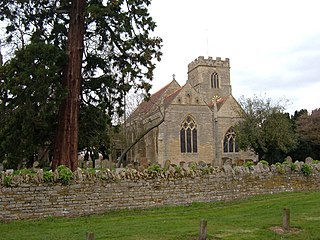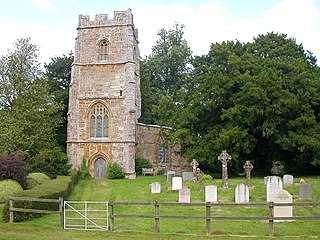
Middleton is a district of Milton Keynes, Buckinghamshire, England, and part of the historic civil parish of Milton Keynes. The district is centred on Milton Keynes Village, the village that gave its name to the City of Milton Keynes, which surrounds it extensively. The village also gives its name to the local civil parish, of which Middleton is the more populated district. It is delineated by Childs Way to the north, Tongwell Street to the east, Chaffron Way to the south and Brickhill Street to the west. The River Ouzel runs diagonally through it, from west to north.
Great Brickhill is a village and civil parish in the unitary authority area of Buckinghamshire, England. It is on the border with the City of Milton Keynes, located 6 miles (9.7 km) south-east of Central Milton Keynes, and 3 miles (4.8 km) in the same direction from Fenny Stratford.

Ludgershall is a village and civil parish in the unitary authority area of Buckinghamshire, England. It is near the boundary with Oxfordshire, about 5.5 miles (9 km) south-east of Bicester and 5 miles (8 km) west of Waddesdon.
Pitchcott is a village and civil parish in the Aylesbury Vale district of Buckinghamshire, England. It is about 3 miles (5 km) north-east of Waddesdon, slightly less than 4 miles (6.4 km) south of Winslow and slightly more than 4 miles north of Aylesbury. It is in the civil parish of Oving.

Wotton Underwood is a village and civil parish in Buckinghamshire, England, 7 miles (11 km) north of Thame, Oxfordshire.

Cosgrove Hall is an early-18th-century Grade II listed country house in Cosgrove, Northamptonshire. It was built on the site of an earlier house by the Furtho family. It is not open to the public. It may have been built by John Lumley of Northampton. In the nineteenth century, the building belonged to John Christopher Mansel. In May 1945, Queen Geraldine of Albania, the Queen consort to King Zog I of Albania, opened a fête at the hall. The building was destroyed by fire in October 2016.

Barnwell is a village in North Northamptonshire in England, 2 miles (3.2 km) south of the town of Oundle, 78 miles (126 km) north of London and 14 miles (22.5 km) south-west of Peterborough. The River Nene runs north of the village, separating it from Oundle.

Potterspury is a populous village and civil parish in West Northamptonshire. The nearest main town is Milton Keynes, the centre of which is about 7 miles south-east. At the time of the 2011 census, the parish's population was 1,453 people.
The Honour of Grafton is a contiguous set of manors in the south of Northamptonshire, England up to the county's eastern border with Buckinghamshire. Its dominant legacies are semi-scattered Whittlewood Forest and a William Kent wing of Wakefield Lodge in the body of that woodland.
Whittlebury is a village and civil parish in the south of the English county of Northamptonshire, close to its border with Buckinghamshire.

Lydeard St Lawrence or St Lawrence Lydiard is a village and civil parish in Somerset, England, situated 7 miles (11.3 km) north west of Taunton in the Somerset West and Taunton district. The village has a population of 506. The parish includes the hamlets of Westowe, Hoccombe and Pyleigh, with its 16th century manor house.

Hullavington is a village and civil parish in Wiltshire, England, just to the north of the M4 motorway. The village lies about 4 miles (6 km) southwest of Malmesbury and 5+1⁄2 miles (9 km) north of Chippenham.

Abthorpe is a village and civil parish in the valley of the River Tove in West Northamptonshire, England, about 4 miles (6.4 km) west of Towcester, 2 miles (3.2 km) northwest of Silverstone and approximately midway between London and Birmingham.
The site of Moor End Castle is situated opposite Moor End Farm, along Moor End Road in the civil parish of Yardley Gobion, within the historic county of Northamptonshire.
Rudgwick is a village and civil parish in the Horsham District of West Sussex, England. The village is 6 miles (10 km) west from Horsham on the north side of the A281 road. The parish's northern boundary forms part of the county boundary between Surrey and West Sussex.

Great Tew is an English village and civil parish in Oxfordshire, about 5 miles (8 km) north-east of Chipping Norton and 8 miles (13 km) south-west of Banbury. The 2011 Census gave a parish population of 156. This qualifies it for an annual parish meeting, not a monthly parish council. The village has largely belonged since the 1980s to the Johnston family, as the Great Tew Estate, with renovations and improvements.

Holton is a village and civil parish in South Oxfordshire about 5.5 miles (9 km) east of Oxford. The parish is bounded to the southeast by the River Thame, to the east and north by the Thame's tributary Holton Brook, to the south by London Road and to the west by field boundaries with the parishes of Forest Hill with Shotover and Stanton St John.

Loddington is a village and civil parish about 3 miles (5 km) west of Kettering, Northamptonshire, England.

Edgcote is a village and former civil parish, now in the parish of Chipping Warden and Edgcote, in the West Northamptonshire district, in the ceremonial county of Northamptonshire, England. It is on the River Cherwell. The parish was bounded by the river to the north and by one of its tributaries to the east. The village is about 5.5 miles (9 km) north-east of Banbury in neighbouring Oxfordshire, and the south-western boundary of the parish formed part of the county boundary. In 2001 the parish had a population of 57.

St Bartholomew's Church is a redundant Anglican church in the former village of Furtho, Northamptonshire, England. It is recorded in the National Heritage List for England as a designated Grade II* listed building, and is under the care of the Churches Conservation Trust. A former medieval village, it became deserted following enclosures that began in the early 16th century and were completed by Thomas Furtho in the 1570s. All that remains in the vicinity of the church is a farm and a dovecote.















